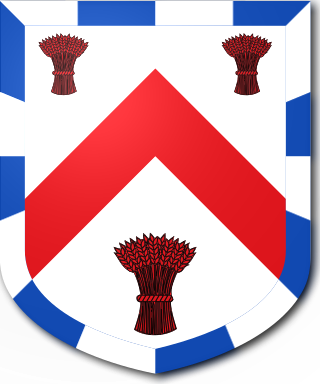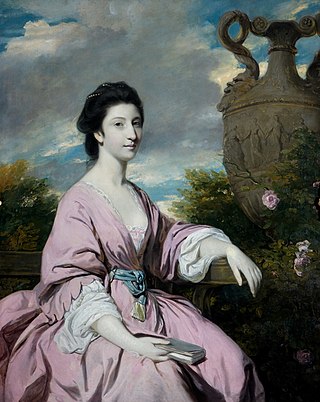Notes
This article needs additional citations for verification .(June 2016) |
- ↑ "No. 27818". The London Gazette . 18 July 1905. p. 4981.
The Birkin Baronetcy, of Ruddington Grange in the parish of Ruddington in the County of Nottingham, is a title in the Baronetage of the United Kingdom. It was created on 25 July 1905 for the businessman Thomas Isaac Birkin. [1] He was a lace manufacturer, director of the Great Northern Railway and the Mercantile Steamship Company. His grandson, the 3rd Baronet, was a racing driver. He died without male issue and was succeeded by his uncle, the fourth Baronet who was succeeded by his nephew, the fifth Baronet. As of 2007 the title is held by the latter's son, the sixth Baronet, who succeeded in 1985.
The heir apparent to the baronetcy is the 6th Baronet's eldest son, Benjamin Charles Birkin (b. 1995).
Coat of arms: Argent, a cross raguly couped vert, in the first and fourth quarters a bee volant and in the second and third a birchtree eradicated all proper. Mantling: vert and argent. Crest: On a wreath of the colours, a scorpion erect proper. Motto: Pace et bello paratus.
This article needs additional citations for verification .(June 2016) |

Baron Berners is a barony created by writ in the Peerage of England.
Lord Belhaven and Stenton, of the County of Haddington, is a Lordship of Parliament in the Peerage of Scotland. It was created in 1647 for Sir John Hamilton, 2nd Baronet, with remainder to his heirs male.

Earl of Stradbroke, in the County of Suffolk, is a title in the Peerage of the United Kingdom. It was created in 1821 for John Rous, 1st Baron Rous, who had earlier represented Suffolk in the House of Commons.

Earl of Cottenham, of Cottenham in the County of Cambridge, is a title in the Peerage of the United Kingdom. It was created in 1850 for the prominent lawyer and Whig politician Charles Pepys, 1st Baron Cottenham. ) He served as Lord Chancellor from 1836 to 1841 and from 1846 to 1850. Pepys had already been created Baron Cottenham, of Cottenham in the County of Cambridge, in 1836, and was made Viscount Crowhurst, of Crowhurst in the County of Surrey, at the same time he was given the earldom. These titles are also in the Peerage of the United Kingdom. The viscountcy is used as a courtesy title for the Earl's eldest son and heir apparent.

Baron Stanley of Alderley, in the County of Chester, is a title in the Peerage of the United Kingdom. It was created in 1839 for the politician and landowner Sir John Stanley, 7th Baronet. Upon his death in 1850, he was succeeded as 2nd Baron Stanley of Alderley and 8th Baronet of Alderley Hall by his son Edward, who was a prominent Liberal politician and notably served as President of the Board of Trade, Postmaster General and had in 1848 been created Baron Eddisbury, of Winnington in the County Palatine of Chester, in his own right. His wife Henrietta was a prominent campaigner for women's education. After his death, the Stanley of Alderley and Eddisbury baronies remained united; most holders have since chosen to be known as Lord Stanley of Alderley. The 3rd Baron Stanley of Alderley had a career in the Diplomatic Service; as he was childless he was succeeded by his younger brother, the 4th Baron. He was liberal member of parliament for Oldham. In 1909, the 4th Baron Stanley of Alderley acquired a further title when he succeeded his first cousin once removed, the Earl of Sheffield, according to a special remainder and thus inherited the title of 4th Baron Sheffield. After his death the titles passed to his son, the 5th Baron Stanley of Alderley. He was Liberal Member of Parliament for Eddisbury and also served as Governor of Victoria. His eldest son, the 6th Baron Stanley of Alderley, sold the family seat of Alderley Hall in 1938. He was married four times, the second time to Sylvia Ashley. On his death the titles passed to his younger brother, who preferred to be known as Lord Sheffield. He only held the titles for three months. As of 2013 the titles are held by the latter's cousin, the 9th Baron Stanley of Alderley, who succeeded his father in that year. He is the grandson of Oliver Hugh Stanley, youngest son of the 4th Baron.

Baron Brabourne, of Brabourne in the County of Kent, is a title in the Peerage of the United Kingdom. It was created in 1880 for the Liberal politician Edward Knatchbull-Hugessen, the second son of Sir Edward Knatchbull, 9th Baronet, of Mersham Hatch. He had previously represented Sandwich in the House of Commons and served as Under-Secretary of State for Home Affairs and Under-Secretary of State for the Colonies. Lord Brabourne had assumed by Royal licence the additional surname of Hugessen in 1849. His son, the second Baron, represented Rochester in Parliament as a Liberal.
Colonel Sir Charles Seely, 1st Baronet KGStJ, DL was a British industrialist and politician.

Sir Henry Ralph Stanley Birkin, 3rd Baronet, known as Tim Birkin, was a British racing driver, one of the "Bentley Boys" of the 1920s.
Sir Stuart Auchincloss Coats, 2nd Baronet was a British politician and Member of Parliament for Wimbledon from 1916 to 1918 and then East Surrey from 1918 to 1922.
Birkin is a surname, and may refer to several people from the same family of Birkin baronets:

Baron Tredegar, of Tredegar in the County of Monmouth, was a title in the Peerage of the United Kingdom. It was created on 16 April 1859 for the Welsh politician Sir Charles Morgan, 3rd Baronet, who had earlier represented Brecon in Parliament. His eldest son, Charles Rodney Morgan, sat as Member of Parliament for Brecon, but predeceased his father. Lord Tredegar was therefore succeeded by his second son, the second Baron.

The Sheffield Baronetcy, of Normanby in the County of Lincoln, is a title in the Baronetage of Great Britain. It was created on 1 March 1755 for Charles Herbert Sheffield, the illegitimate son of John Sheffield, 1st Duke of Buckingham and Normanby. On the death of his half brother, the 2nd Duke, in 1735, he inherited the family estates including Buckingham House which was sold to George III in 1762 and Normanby Hall which latter remained the family residence until 1963. Thereafter the family's home was Sutton Park, York.

The Smithson Baronetcy, of Stanwick in the County of York, is a title in the Baronetage of England. It was created on 2 August 1660 for Hugh Smithson (1598-1670) of Stanwick St John, Yorkshire. Sir Hugh Smithson, 3rd Baronet, married Elizabeth Langdale, daughter of Marmaduke Langdale, Baron Langdale. Sir Hugh Smithson, the fourth Baronet, married Lady Elizabeth Seymour, daughter of Algernon Seymour, 7th Duke of Somerset and heiress of the Percy family, Earls of Northumberland. In 1749 the Duke of Somerset was created Earl of Northumberland, with remainder to his son-in-law Sir Hugh Smithson, who succeeded as second Earl on his father-in-law's death in 1750. He assumed the surname of Percy and was created Duke of Northumberland in 1766. The baronetcy remains merged with the dukedom.
There has been one baronetcy granted to the Lauder family. The baronetcy of Lauder of Fountainhall, Haddingtonshire, was created for John Lauder, last surviving male representative of the Lauders of that Ilk, a rich merchant-burgess and sometime Treasurer and baillie of the City of Edinburgh, and an armiger. He purchased the estate of Newington, Edinburgh, and subsequently the lands of Woodhead and Templehall near Pencaitland, which along with others in Edinburghshire and Haddingtonshire, were erected by Crown charter into the feudal barony of Fountainhall on 13 August 1681.
There have been five Baronetcies created for people with the surname Forbes, four in the Baronetage of Nova Scotia and one in the Baronetage of the United Kingdom. The first holder of the Burn Baronetcy of Jessfield, created in the Baronetage of the United Kingdom in 1923, assumed the surname of Forbes-Leith of Fyvie in 1925.

There have been twenty one baronetcies created for persons with the surname Williams, eight in the Baronetage of England, three in the Baronetage of Great Britain and ten in the Baronetage of the United Kingdom. Only six of the creations are extant as of 2017.

Theodosia Hawkins-Magill, later Countess of Clanwilliam, was a great heiress and landowner in County Down, Ireland.

The Trollope Baronetcy, of Casewick in the County of Lincoln, is a title in the Baronetage of England. It was created on 5 February 1642 for Thomas Trollope. The seventh Baronet was a Conservative politician. In 1868 he was raised to the Peerage of the United Kingdom as Baron Kesteven, of Casewick in the County of Lincoln. The barony became extinct in 1915 when the third Baron was killed in action in the First World War. The late Baron was succeeded in the baronetcy by his cousin, the tenth Baronet.
There have been two baronetcies created for members of the Haggerston, later Constable Maxwell-Scott family, one in the Baronetage of England and one in the Baronetage of the United Kingdom. Only one creation is extant as of 2008. The Haggerston, later Constable Maxwell-Scott Baronetcy, of Haggerston in the County of Northumberland, was created in the Baronetage of England on 15 August 1642 for Thomas Haggerston, of Haggerton Castle, Northumberland, a loyal Royalist who served as a colonel in the army of King Charles I. The Haggerston were recusant in the 17th century and the estates were sequestered and forfeit to the Commonwealth of England in 1649 but were repurchased by the first Baronet in 1653. The line of the fourth Baronet failed on the death of the twelfth Baronet in 1972. The title reverted to the line of William Haggerston, second son of the third Baronet and younger brother of the fourth Baronet. In 1746 he inherited estates in Yorkshire from his great-uncle Sir Marmaduke Francis Constable, 4th and last Baronet, of Everingham, and assumed the surname of Constable in lieu of his patronymic. In 1758 he married Winifred, daughter of Robert Maxwell, titular sixth Earl of Nithsdale, and assumed by Royal licence the additional surname of Maxwell. Winifred was considered to be the heiress to the Scottish lordship of Herries of Terregles held by her father. Constable-Maxwell built a new house at Everingham Park on the Constable estate in Yorkshire.
Three baronetcies were created for different families bearing the name of Halford, but related to one another. The first baronetcy was created in 1641 for Richard Halford in the Baronetage of England. It became extinct in 1780 with the death of the seventh and last baronet. The second baronetcy was created in 1706, also in the Baronetage of England, but became extinct in 1720 in the second generation. The third and last baronetcy was created in 1809 in the Baronetage of the United Kingdom for a prominent physician descended maternally from the fifth Baronet of the previous creation. It too became extinct with the death of the fourth Baronet in 1897.